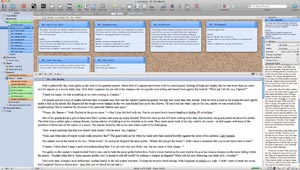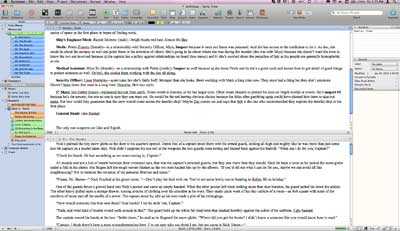This week’s Scrivener Saturday – Five Ways to Use Split Screen Beyond the Corkboard & Outline Views.
Seems like a no-brainer, right? I’ve run into quite a few authors who didn’t know that the split screen in Scrivener wasn’t limited to index cards (the corkboard) and outline mode. See picture below:

What I haven’t seen is people using it like this:

So what did I do differently? I opened another document of mine up top instead. Other than index cards or outline view, here are Five Ways to Use Split Screen:
- Use it to have a running list of vocabulary for your world while you work so you never forget or misspell a word.
- Use it to have a running list of “fact checks.” (These are notes to myself such as ‘Check how tall the Empire State building is for chapter 2’ that I’ll do during revisions.)
- Use it for a list of your characters & their descriptions. No more Susie having blue eyes in chapter 1 and brown eyes in chapter twenty.
- Use it to display a map of your kingdom, galaxy/universe, starship, city, etc. No more navigational snafu’s.
- Use it to display research relevant to the scene you’re currently writing (which you could also display in the document notes on the right).
What I Love about This Feature: You can split screen with any two documents, so this feature is only limited to your imagination. You can also split screen horizontally or vertically.
Downside to This Feature: Depending upon what you put in the splits, the screen can get a tad cluttered, but that’s what full screen composition mode is for.
Check out the entire series of Scrivener Saturday posts here.


